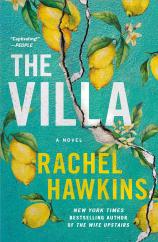The Villa
Review
The Villa
Rachel Hawkins, who is known for her gothic suspense novels THE WIFE UPSTAIRS and RECKLESS GIRLS, turns her eye to sunny, mysterious Italy in THE VILLA. Ambitious and seemingly impossible, this mash-up of the histories of Fleetwood Mac, the Manson murders and the writing of FRANKENSTEIN more than delivers.
In the summer of 1974, Mari Godwin, the daughter of noted writer and bohemian William Godwick and feminist wartime journalist Marianne Wolseley, is still reeling from the death of her baby at nine months old. Billie, as he was known, was the illegitimate son of Mari and her lover, the married Pierce Sheldon, a musician who swept her off her feet when she was only 16, officially severing ties to her family and casting him as a Lothario-esque villain (whose wife was only 15 when he met her). It has been more than a year, and Mari and Pierce are just starting to find their footing again as a couple: Mari is focused on her writing, and Pierce has begun to generate buzz for his music.
"This book is a perfect example of taking a commonly known story or famous history, and not just referencing it, but truly building on it to create something fresh, original and deliciously devious."
So when Mari’s stepsister, Lara, announces that she has been sleeping with a famous musician, Noel Gordon, and he has invited the three of them to his Italian villa to write, create and party, the answer seems obvious. Mari will take inspiration from the Italian countryside, Lara will find a relationship of her own, and Pierce, of course, will dazzle Noel with his talent and rocket to superstardom himself. But when a group of creatives --- and enough booze and drugs to fuel a small country --- come together during the summer of free love and unlabeled relationships, disaster seems inevitable.
Several decades later, mid-divorce Emily is struggling with her own writing. She is the moderately successful author of a series of cozy mysteries. But as she was preparing to write the latest installment, she became ill with a set of confusing symptoms: dizziness, brain fog, nausea and a cheating spouse. She has just started to recover (mysteriously, as no doctor was ever able to diagnose her with anything concrete) when her soon-to-be ex-husband drops a bombshell: he wants a huge cut of her writing royalties. With legal bills piling up, writer’s block rearing its ugly head, and the pressure mounting to write something not just good but bestselling, it’s clear why she has found herself frozen.
When Emily agrees to have lunch with her longtime best friend, Chess, now a bestselling self-help guru, she can’t possibly expect what comes next: Chess has rented an Italian villa for the summer, and she wants Emily to join her there to embark on a six-week-long slumber party. Maybe, Emily thinks, her ability to write will return and she can finally move on.
But Emily is not the first writer to stay in Orvieto's Villa Aestas. In 1976, a young Mari penned a feminist horror masterpiece, Lilith Rising, that not only broke the glass ceiling of the formerly male-dominated genre but changed the path of horror writing forever. And then there’s the story of a homicide. As Emily discovers in her research, Villa Aestas is an honest-to-God Murder House, the site of the murder of a 1970s rocker that has long been attributed to the sex, drugs and rock ‘n’ roll lifestyle but hints at something much, much darker.
As Emily and Chess indulge in the fineries of the Italian countryside, Emily starts to feel refreshed, not to mention inspired by the villa and some of its former inhabitants. When she discovers a mysterious link between Mari, the villa and the writing of Lilith Rising, she starts working on a new, highly ambitious project that is part memoir, part true crime and part history. But when her husband catches wind of this, he is quick to inform her --- and their lawyers --- that he wants proceeds from this endeavor, too. Only this time it appears that Emily has a real bestseller on her hands, and she’s not ready to relinquish another dime of her hard work to someone like him. Or Chess, who has become adamant that this will be the Book that they dreamed of writing together when they were young.
As Emily digs deeper into Mari’s history and the murderous summer she spent at the villa, her perceptions of her relationships darken --- and she is forced to question not only her husband, but her best friend as well.
The allusions that Hawkins employs in THE VILLA are easily identifiable: the novel is a thinly veiled reimagining of the summer when Mary Shelley, Percy Bysshe Shelley and Lord Byron held a ghost story contest that resulted in FRANKENSTEIN. But while the characters are clear reproductions, they brim with life and energy, and Hawkins' own creations take on a fascinating plotline of their own as Emily tries to discover what really happened during the summer of 1974 and whether or not Chess is using her.
As the present-day and 1974 plotlines start to mirror and inform one another, Hawkins maintains two fascinating, riveting and unexpectedly poignant stories about the muse vs. the artist, creation vs. fame, and, of course, art vs. artist. This book is a perfect example of taking a commonly known story or famous history, and not just referencing it, but truly building on it to create something fresh, original and deliciously devious.
With its storied history in FRANKENSTEIN and its forward-facing, refreshingly modern discussion of how we read meaning into the works of (especially female) artists, THE VILLA is much greater than the sum of its parts. It is also proof that there is no gothic classic that Hawkins cannot modernize, refresh and completely make her own.
Reviewed by Rebecca Munro on January 6, 2023




